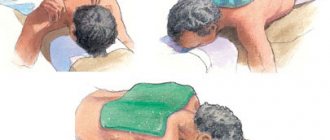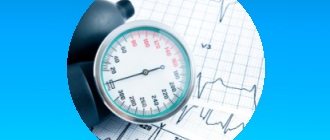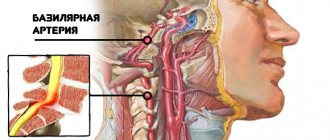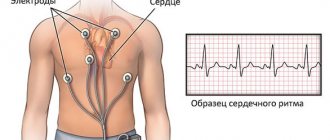- What does upper and lower pressure show?
- What can lead to a decrease in lower pressure?
- Types of arterial hypotension
- Causes of low lower pressure
- Mechanisms of reduction in systolic and diastolic pressure
- Symptoms
- Diagnostic procedures
- Treatment methods
The state of low blood pressure is called arterial hypotension. It occurs if the readings fall below 100/60 mmHg. In some patients, upper and lower pressure (systolic and diastolic) decreases. Sometimes a situation arises when the upper indicator is normal, and the lower indicator falls below normal. This is regarded as isolated arterial hypotension and requires the attention of specialists.
What does upper and lower pressure show?
The upper pressure is called systolic. It refers to the force with which blood is pushed out of the heart and moves through the vessels, saturating organs and tissues with oxygen. Diastolic - lower pressure, indicates the pressure of blood on the walls of blood vessels at the moment between heartbeats.
As a rule, as people age, they experience an increase in upper blood pressure. Elevated lower levels are more common in patients under 50 years of age and then begin to decline. Problems with diastolic pressure begin due to deterioration in the elasticity of blood vessels. The capillaries narrow, become stiffer, and this leads to excess blood pressure on their walls. This phenomenon is observed even at rest.
How to protect yourself from blood pressure changes
A healthy lifestyle is what can raise low and lower high blood pressure, bringing it closer to normal levels. This does not mean that a chronic hypertensive patient who stops consuming salt will become absolutely healthy, but he will be able to reduce the number of attacks.
The best foods for heart and vascular health
Measures to prevent both low and high diastolic pressure are as follows:
- Complete cessation of smoking, which makes blood vessels fragile and reduces lung capacity.
- Mandatory physical activity appropriate to the person’s age and health status.
- Reducing the amount of salt in the diet (relevant for hypertensive patients).
- Losing weight if you are overweight, which is one of the main factors that increases the risk of developing cardiovascular diseases.
- Regular walks in the fresh air allow you to saturate your blood with oxygen.
- Maintain a sleep schedule (at least 8 hours at night).
- Proper nutrition, taking into account the body's needs for proteins, fats, carbohydrates, vitamins and microelements. Thus, by increasing the level of unsaturated fats in the diet and reducing the amount of saturated fats, you can prevent the formation of cholesterol plaques that accompany almost any vascular pathology.
What can lead to a decrease in lower pressure?
Arterial hypotension can act as an independent disease (primary form) or one of many symptoms (secondary form). According to statistics, low upper and/or lower blood pressure is more common in women than in men. This phenomenon can also occur in adolescents.
In older people, lower blood pressure decreases due to decreased vascular tone. The main culprit of the problem is atherosclerosis. Secondary hypotension can occur against the background of neurological and cardiac diseases, and hormonal disorders.
Types of arterial hypotension
There are three types of arterial hypotension:
- physiological;
- pathological;
- symptomatic.
Low blood pressure as a physiological norm may be a congenital feature characteristic of a particular person due to his constitutional type. A similar situation is observed among professional athletes, residents of high mountain areas and tropical latitudes. Thanks to the decrease in pressure, the body adapts to physical activity and climate conditions. In this case we are talking about a compensatory function.
The pathological form of the disease is of two types: orthostatic and neurocirculatory. Orthostatic hypotension occurs when there is a change in body position when a person gets up after resting or sleeping. The neurocirculatory form is associated with disruption of the autonomic nervous system. The patient may periodically experience low blood pressure or have hypotension, in which diastolic pressure is chronically low.
Symptomatic hypotension is secondary. Its causes are disruption of the functioning of various organs and systems, intoxication.
Treatment
Many people know how to treat diastolic blood pressure (high), but low blood pressure is much less common, so people are not aware of how to increase it. This technique consists of several methods of therapy: nonspecific and medicinal. They differ in the method of treatment.
Nonspecific therapy
Such treatment makes it possible to enhance the effect of drug therapy and protect the body from circumstances that provoke low blood pressure. Such recommendations are well suited for healthy people as a preventive measure against low blood pressure.
- Sleep well. The daily sleep requirement is at least 8 hours.
- During work, take short breaks (15 minutes), every 2-3 hours.
- Do morning exercises outside and walk. Every day a person should be in the fresh air for at least 2-3 hours.
- Strengthen vascular walls and train their elasticity using a contrast shower: gradually reducing the water temperature from hot to cold. In this way, both high and low diastolic pressure can be slightly corrected.
- Massage, knead and rub the body, especially the calf muscle tissue, areas of the hands and feet.
- Avoid hot baths, baths, saunas, and exposure to sunlight without a hat or headscarf.
- Cycling, rollerblading, skating, and light jogging more often.
- Drink strong teas and coffee drinks. For low blood pressure, ginger tea is recommended, purchased in a store or prepared independently from ginger root, grated on a fine grater. However, you should not regularly stabilize intravascular parameters using this method, because you can disrupt the natural self-regulatory abilities of the body.
If you devote enough time to the lifestyle described above, but the diastolic values of the tonometer are still low, you will need to resort to drug treatment.
Medicines
This therapy does not tolerate self-prescription. Before purchasing medications, you need to consult with a specialist who will determine the exact causes and indicate the path to treatment of the disease. If you postpone a visit to the doctor, you will have to get rid of not only intravascular abnormalities, but also diseases of the internal organs. The following medications are usually applicable:
- Herbal products: ginseng, eleutherococcus, lemongrass. They create a tonic and stimulating effect on the human body. They have contraindications for use, so medical consultation will be necessary, regardless of the origin of the drugs.
- With reduced tonometer values, combined with asthenia, manifested in the form of apathy and weakness, Pantogam, Paricetam, Phenibut, which belong to the nootropic group, are used. They improve metabolic processes occurring within a person, stimulate the central nervous system and activate energy processes.
- Multivitamins tone the human body, replenish the vitamin balance in the body, as a result of which the patient becomes resilient to nervous and physical stress.
The methods described above are best used in combination: nonspecific therapy together with medication (for serious deviations). If a person only occasionally experiences attacks of hypotension, then preventive measures alone can be used. But you should still consult a doctor to rule out the disease in a latent form.
Causes of low lower pressure
According to statistics, the main cause of primary hypotension is neurocirculatory dystonia (NCD). It is otherwise called heart neurosis. With neurocirculatory dystonia, various disorders of autonomic regulation are observed, and this condition is not associated with damage to the endocrine or nervous systems.
NCD and the resulting decrease in diastolic pressure are most often observed in women during puberty and at the onset of menopause, with impaired ovarian function. In young people and middle-aged patients, hypotension occurs against the background of chronic fatigue, stress, psycho-emotional and physical overload. The high-risk group includes people with alcohol and tobacco addiction, patients who have recently experienced psychological trauma, and who are depressed.
Secondary arterial hypotension can be acute or chronic. Low diastolic pressure is encountered by patients with stomach ulcers, diabetes, low thyroid function, osteochondrosis, arrhythmia, heart failure, and chronic infectious processes. In people with such diseases, blood pressure may be constantly low, but due to the body's ability to adapt, the disease does not manifest itself with pronounced symptoms.
A sharp drop in upper and lower blood pressure occurs with significant blood loss, dehydration, anaphylactic shock, or poisoning. These conditions are extremely dangerous for health and life, as they lead to serious circulatory disorders.
One of the possible reasons for a decrease in diastolic blood pressure is a lack of vitamins B, C and E in the diet. The body can also respond to a strict diet or an overdose of drugs (adrenergic blockers, anti-hypertension drugs) with arterial hypotension.
Diagnostics
Low lower blood pressure can be diagnosed using a conventional tonometer. This indicator characterizes the last tone that is heard in the area of the cubital fossa during deflation of the cuff. It is recommended to measure blood pressure while sitting, standing and lying on your back.
The main question facing the doctor is: why is the lower pressure low? This pathology is mainly dealt with by cardiologists or neurologists. The standard set of studies includes an electrocardiogram, echocardiography, biochemical blood parameters (liver and kidney tests, acute phase parameters), blood electrolyte composition, and 24-hour blood pressure monitoring.
If the test results are normal, they seek the help of an endocrinologist to identify possible hormonal imbalances. The functions of the adrenal glands and thyroid glands are most often tested. In addition, to make a diagnosis of connective tissue dysplasia, geneticists are often sought for advice.
In acute conditions of a sharp decrease in blood pressure, the time for a diagnostic search is usually limited. The first priority is to help the patient. The diagnosis is made on the basis of a clinical emergency that caused a drop in lower blood pressure.
Mechanisms of reduction in systolic and diastolic pressure
A decrease in blood pressure is caused by one of four possible reasons:
- the stroke and cardiac output decreases;
- the flow of blood to the heart through the veins decreases;
- vascular resistance decreases;
- the volume of circulating blood decreases.
A decrease in cardiac output and stroke is observed in cases of disturbances in myocardial function caused by infarction or myocarditis. The same situation occurs with an overdose of adrenergic blockers.
Vascular tone can decrease with infectious diseases, intoxication, and anaphylactic shock.
A decrease in the volume of circulating blood occurs against the background of bleeding due to trauma to tissues and blood vessels, rupture of the spleen, and ulcerative lesions of the stomach.
A decrease in venous return of blood to the heart occurs with massive ascites or pleurisy due to blood retention in the smallest vessels.
Symptoms
With a physiological decrease in lower pressure, patients do not experience a deterioration in their well-being. If the problem is caused by pathology, then oxygen starvation gradually develops. It is characterized by the following symptoms:
- weakness and dizziness;
- colored spots before the eyes;
- pallor;
- fainting state.
Patients with chronic arterial hypotension constantly feel fatigue, drowsiness, and a desire to rest. A person with low blood pressure experiences increased sweating and may experience headaches. Low blood pressure makes it difficult to concentrate on work or study and makes a person emotionally unstable. Women with chronic hypotension may experience menstrual irregularities, and men have reduced potency.
In severe forms of arterial hypotension, patients experience vegetative crises. They are accompanied by a decrease in temperature, sweating, difficulty breathing, chest pain, nausea and vomiting, slow pulse, and loss of consciousness.
Associated symptoms
When blood pressure decreases, blood flows to the internal organs and brain in insufficient quantities, which causes pale skin, blue lips, and cold hands and feet. It is important to pay attention to systolic pressure - these symptoms are observed when the upper readings remain within normal limits or decrease slightly.
In the case of systolic hypertension, when the lower pressure is less than normal and the upper pressure is increased, a person experiences the following sensations:
- headaches and dizziness;
- redness of the skin of the face;
- dyspnea;
- cardiopalmus;
- tremor of the limbs.
If diastolic pressure drops sharply, a person feels weak, lethargic and lacks strength.
High systolic pressure with low diastolic pressure always manifests itself as severe discomfort for a person and requires medical attention. Moreover, the severity of symptoms depends on how much the upper pressure has changed and the lower pressure has decreased; a large difference directly affects well-being.
Diagnostic procedures
To normalize blood pressure, it is important to identify the reasons for its decrease. The approach to diagnosing arterial hypotension is complex. First of all, the doctor needs to assess the blood pressure level. Daily monitoring is best suited for these purposes. The procedure helps to identify how pressure readings change during the day. A technique for measuring blood pressure three times with an interval of 3-5 minutes is also used.
To choose treatment, you need to determine whether a decrease in lower pressure is an independent disease or a symptom of another disease. The patient is prescribed laboratory tests for hormones, electrolytes, glucose and other indicators. Among the hardware methods for diagnosis, electroencephalography, ECG, and orthostatic test are used.
A person with chronic arterial hypotension needs to consult a neurologist, cardiologist, or endocrinologist.
Piracetam
- Helps improve brain activity;
- Increases concentration and improves cognitive functions;
- Promotes recovery after various cerebral injuries due to hypoxia, intoxication or electroconvulsive therapy.
More details
THERE ARE CONTRAINDICATIONS. BEFORE USE, READ THE INSTRUCTIONS CAREFULLY OR CONSULT A DOCTOR
What indicators can be considered low
We all know that normal blood pressure in an adult is considered to be 120/80. In this case, the second number is the diastolic pressure. It can be assumed that all data that is below 80 should be considered pathological. But, it should be understood that each person is individual, just like his body.
Some people live their whole lives with a blood pressure of 110/70 or other indicators, and at the same time they feel very good. Accordingly, a deviation should be considered that value that is below the norm that is customary for a particular person.
Important! Usually we can talk about pathologically low DD in cases where its indicators are less than 60. Here you should consult a doctor and undergo a full examination.











